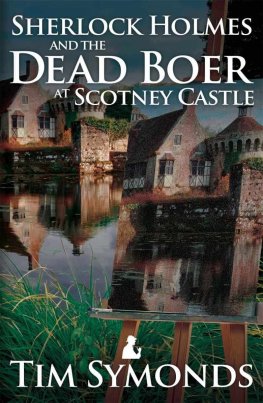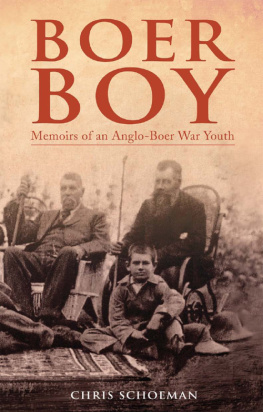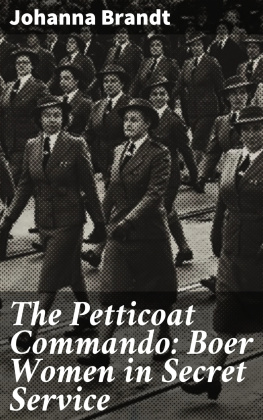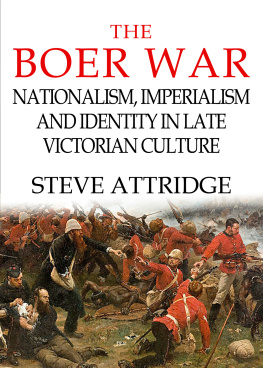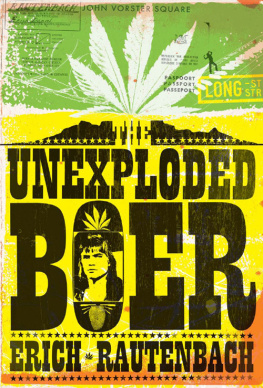Martin P. Bossenbroek - The Boer War
Here you can read online Martin P. Bossenbroek - The Boer War full text of the book (entire story) in english for free. Download pdf and epub, get meaning, cover and reviews about this ebook. year: 2018, publisher: Seven Stories Press, genre: History. Description of the work, (preface) as well as reviews are available. Best literature library LitArk.com created for fans of good reading and offers a wide selection of genres:
Romance novel
Science fiction
Adventure
Detective
Science
History
Home and family
Prose
Art
Politics
Computer
Non-fiction
Religion
Business
Children
Humor
Choose a favorite category and find really read worthwhile books. Enjoy immersion in the world of imagination, feel the emotions of the characters or learn something new for yourself, make an fascinating discovery.
- Book:The Boer War
- Author:
- Publisher:Seven Stories Press
- Genre:
- Year:2018
- Rating:5 / 5
- Favourites:Add to favourites
- Your mark:
- 100
- 1
- 2
- 3
- 4
- 5
The Boer War: summary, description and annotation
We offer to read an annotation, description, summary or preface (depends on what the author of the book "The Boer War" wrote himself). If you haven't found the necessary information about the book — write in the comments, we will try to find it.
The Boer War — read online for free the complete book (whole text) full work
Below is the text of the book, divided by pages. System saving the place of the last page read, allows you to conveniently read the book "The Boer War" online for free, without having to search again every time where you left off. Put a bookmark, and you can go to the page where you finished reading at any time.
Font size:
Interval:
Bookmark:


First published in 2012 by Athenaeum Polak & Van Gennep, Singel 262, 1016 AC Amsterdam, Netherlands
First published in English by Jacana Media (Pty) Ltd in 2015
First Seven Stories Press edition January 2018.
Text Martin Bossenbroek 2012
Translated into English by Yvette Rosenberg
| This book is published with the support of the Dutch Foundation for Literature. |  |
All rights reserved. No part of this book may be reproduced in any form or by any means, electronic or mechanical, including photocopying, writing or recording, or through any other system for the storage or retrieval of information without the written permission of the publisher.
Seven Stories Press
140 Watts Street
New York, NY 10013
www.sevenstories.com
Library of Congress Cataloging-in-Publication Data
Names: Bossenbroek, M. P., author. | Rosenberg, Yvette, translator.
Title: The Boer War / Martin Bossenbroek ; translated by Yvette Rosenberg.
Other titles: Boerenoorlog. English.
Description: Seven Stories Press first edition. | New York ; Oakland : Seven
Stories Press, 2017.
Identifiers: LCCN 2017001137 (print) | LCCN 2017002436 (ebook) | ISBN
9781609807474 (hardcover) | ISBN 9781609807481 (Ebook)
Subjects: LCSH: South African War, 1899-1902. | Leyds, Willem Johannes,
1859-1940. | Churchill, Winston, 1874-1965. | Reitz, Deneys, 1882-1944.
Classification: LCC DT1896 B6713 2017 (print) | LCC DT1896 (ebook) |
DDC
968.048--dc23
LC record available at https://lccn.loc.gov/2017001137
Printed in the USA.
9 8 7 6 5 4 3 2 1
Prologue Heritage Day
Bloemfontein, 24 September 2011
Part I For a good cause
June 1884 October 1899
Part II Like a boys adventure story
October 1899 June 1900
Part III Death and destruction
June 1900 May 1902
Epilogue Winners and losers
Bloemfontein, 6 July 2012
If there is any place where the memory of the Boer War is kept alive, it is in Bloemfontein, the seat of South Africas Supreme Court of Appeal. This is where both the National Party and the African National Congress (ANC) were conceived, though there is little to see that recalls either of those historic events. But the city does have a worthy memorial to the war fought by the former Boer republics of the Transvaal and the Orange Free State against Great Britain in 18991902. It consists of a monument and a museum standing side by side in a large park.
Understandably, no one wants to remember Bloemfontein as the place where the seeds of the reviled apartheid system were sown. In 1914, however, it saw the establishment of the National Party, which came to power in 1948 with an official policy of racial segregation. The embodiment of white supremacy is not something to be commemorated or inscribed in stone.
The founding of the ANC is a different matter. Originally the South African Native National Congress, the ANC was established on 8 January 1912, two years before the National Party, in a small church near the railway station in Fort Street. It took power from the white regime in 1994 and has governed the country ever since. The church in which it first saw the light of day is now a liberation heritage site. Like Nelson Mandelas prison cell on Robben Island, it has become a cultural and historical memorial to African nationalism.
At least, that was the plan, but it hasnt yet materialised. For years, no one had given the building a second glance. It was only recently rediscovered in the run-up to the ANCs centennial celebrations. The problem, however, is that the church is currently being used for a different purpose. It is a panel-beating workshop and appears to be doing a good trade. The yard is littered with car wrecks and waste. Time is running out. The owner knows what his property is worth, but in spite of that ANC spokesmen are confident that hell be moving out soon and that the building will be restored to its original state by 8 January 2012.
Time isnt an issue in Monument Road, just a few kilometres away. The two structures dedicated to the Boer War have stood there for decades. The Bauhaus-style museum dates from 1931. The monument is a towering obelisk, 35 metres tall. Unveiled in 1913, it is nearly as old as the ANC.
The park they stand in is an oasis of peace, with manicured lawns and rustling trees. Even so, it has a boom at the entrance and observes opening hours. Time seems to have stood still. A stroll through the grounds strengthens this impression. The entire park is a memorial site, in 1950s style, just as it was meant to be. There are statues, guns and railway carriages, a wall of remembrance and a group of sculptures at the foot of the obelisk, all telling the story of the struggle and suffering of the Boer nation in their Second War of Liberation. For that is what they themselves called the war they fought against the British after an earlier conflict in 188081.
It is the story of two insignificant Boer republics forced into war by the imperialist superpower Great Britain. Surprised and exasperated by their successful resistance, first in conventional combat and later in a protracted guerrilla war, the British commanders resorted to a campaign of terror against the civilian population. As a result, the Boers became victims of persecution as well as heroes. This is the narrative the park conveys.
Three sculptures symbolise different stages of the war. Farewell 11-10-1899 represents a militant young Boer leaving for the front at the outbreak of war. The Exile depicts a man and his grandson at the railing of a ship, representing the thousands of Boer prisoners of war whom the British sent to camps overseas. The Diehard 31 May 1902 illustrates the plight of the surviving commandos at the end of the war. It shows a battle-weary Boer on an emaciated horse, exhausted from years of hardship and deprivation, but with head held high.
These are the memories preserved here. It is the story of David and Goliath, except that this David was forced to surrender under the pressure of unendurable suffering. This is expressed on the circular plinth on which the column rests. An inscription between the sculptures and the plaques reads: This National Monument has been erected in commemoration of the 26,370 women and children who died in the concentration camps as well as other women and children who succumbed elsewhere as a result of the war of 18991902. Unveiled on 16th December 1913.
Visitors today might be misled by the inscription. Since the Second World War the term concentration camps has been associated with the Nazis systematic murder of the Jews, but that is not what it meant in 1913. In the light of what we know today, it would be more accurate to call the British camps internment camps, because that is what they were. And they were massive.
Commander-in-Chief Lord Roberts and his successor, Lord Kitchener, hoped that removing the civilian population from the war zone would force the Boer commandos to surrender. Some 115,000 people, mostly women and children, were rounded up and incarcerated in appalling conditions, where almost a quarter of them, mainly children, perished. The population of the two Boer republics was decimated.
Font size:
Interval:
Bookmark:
Similar books «The Boer War»
Look at similar books to The Boer War. We have selected literature similar in name and meaning in the hope of providing readers with more options to find new, interesting, not yet read works.
Discussion, reviews of the book The Boer War and just readers' own opinions. Leave your comments, write what you think about the work, its meaning or the main characters. Specify what exactly you liked and what you didn't like, and why you think so.


